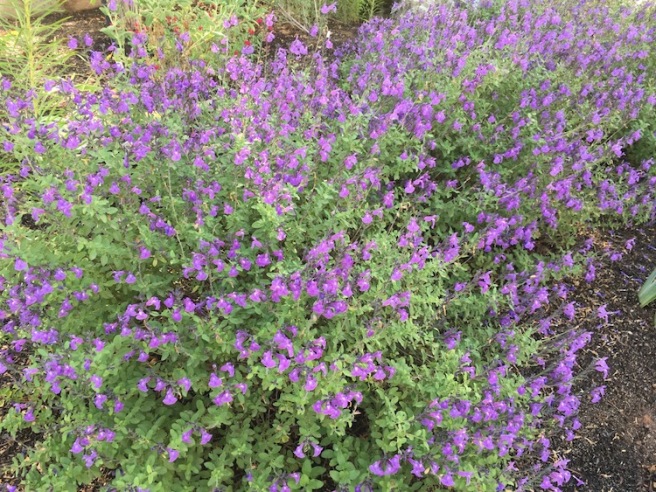
Perhaps you remember this box of precious finds from my post on the Spring Plant Sale at the UC Berkeley Botanical Garden. Center stage is Salvia ‘Big Swing’, one of several totally new to me salvias I saw that day. I got it in the ground in my front garden in early May but of course failed to photograph it. As I gave it a good large open space the photograph would have only shown the velvety leaves about 6″ tall surrounded by a vast sea of humus!

It has been an exciting summer venturing away from the many twiggy, small leafed salvias I’ve grown for several years. Selections from the greggii and microphylla species are very successful here and bloom almost year around given periodic cutting back as the blooms fade. Below, Salvia ‘Mesa Azure’ is my enduring favorite with its nice mix of flowers and brighter green foliage. It has also been tough as nails in terms of weather and water.


Feeling the need to expand my salvia horizons into some of the more tender perennial species I having been picking up whatever I find on my gardening travels, usually just a single plant to trial as I did with ‘Big Swing’.
Salvia ‘Big Swing’ originated as a chance seedling between S. macrophylla and S. sagittata and was brought to gardens by noted Bay Area salvia expert Betsy Clebsch. I also purchased a Salvia sagittata but it has not been as successful for me as ‘Big Swing’ which purports to be more compact than its parent.

The foliage was fast growing to a lovely mound of large, almost chartreuse green arrow shaped leaves. Both the leaves and stems are soft and somewhat downy. This is my second wave of branched flower stalks–the first flush having been cut back in August. The flowers are not especially numerous but prominently held high above the foliage.


The saturated cobalt blue flowers are almost electric and their shape interesting in the salvia world. On a breezy day the blooms appear as dancing butterflies atop the wiry stems.


‘Big Swing’ is a tender perennial having hardiness only to USDA zone 10a according to one of my references. Annie’s Annuals in Richmond, CA lists zones 8-10 which is more hopeful for me–could be dicey to overwinter in my zone 9 so I may cut back, mulch and cover before our cooler weather sets in. Even if I lose this one, I would gladly treat it as an annual just to be able to enjoy it every year. Finding it again locally will be a challenge but that is what road trips are for! On the other end of the weather spectrum reference notes that it may require some afternoon shade and adequate water in the sunniest climates. My ‘Big Swing’ is in true full sun (southern) until very late afternoon and has done fine within the parameters of my weekly automatic sprinkler schedule. Of note is that the parent species S. sagittata purchased and planted at the same time does get some afternoon shade and perhaps a bit more water. It is half the size and has very few flower stalks!
Salvia ‘Big Swing’ gets an A+ for performance in my garden. For interesting information about great salvias for your garden check out any of the books written by Betsey Clebsch including The New Book of Salvias: Sages for Every Garden (Timber Press 2003).

Beautiful – love the brilliant colors of your flowers.
LikeLike
These blue blossoms are so lovely!
LikeLike
Those certainly are some flashy ones. The natives are as foliar as they are floral. We have a few black sage at work that bloom nicely, but are not so flashy. The aromatic foliage is probably my favorite for salvias because, for me, it is the most familiar of the native salvias. It is a garden variety, so does not look quite the same, but the aroma of the foliage is indistinguishable. Anyway, the more colorful sorts like yours are not often found in nurseries. You would think that the more colorful sorts would be more popular. Salvia greggii sorts are always available of course.
LikeLike
You are right that many of the more interesting ones aren’t easily found so it’s all the more special when I happen on one that is new to me (only seen on reference materials) to try. The flowers on this one are smaller and not all that close to each other so are better viewed up close. The branching habit of the flower stalks makes for some structural interest up off the ground in the garden.
>
LikeLiked by 1 person